VVAM Newsletter 11 – 1983
September 1983.
Editor:Drs.R.P.G.A.Voskuil.
English translation:Susana G.Beek-Hobart.
Dear Friends,
We consider our first “Day with a Special Theme” to have been a real success. There was a great amount of interest shown by the participants.The various pre-parations undertaken by Messrs.van Roekel and Voskuil,the chosen route,as well as the photo material and the accompanying explanations were excellent.lt is more than certain that we shall now continue on this footing.
The Society of Friends’presence at the Open Day of the Klu at the Deelen Air Base was for the purpose of propaganda and sales for the benefit of the Museum and the Society.Our presence also during the special days organised for the handicapped in Arnhem’s Eusebius Church,as well as the Open Day at the LETS in Schaarsbergen were for the same purpose.Under the inspired guidance of Mrs.de Langen,these activities can be described as succesful:a number of new members, a respectable financial result and the stimulation of many visitors to visit the Museum.From some of the conversations,it was apparent that many did not even know that the Museum in “Hartenstein” had already celebrated its fifth anniver¬sary!
During the Airborne Walk,which will take place on the forthcoming 3rd September, we propose to set up a propaganda/sales stand along the Utrechtseweg in Ooster¬beek. The profits of the Walk,which is organised by the Renkum’s Police Sport Association,are mainly for the benefit of the Foundation “Lest We Forget”,which in its turn gives financial support to the Arnhem Veterans and relatives who are unable to finance a pilgrimage to Oosterbeek/Arnhem.
J.Smits,Chairman.
Brigadier G.Chatterton to lead the 39th Arnhem Pilgrimage.
This September,Brigadier George Chatterton will be the leader of the English pilgrims during the 39th Arnhem Commemoration.During the war,Chatterton conduc¬ted the building up and the organisation of the Glider Pilo’t Regiment.When,on the 17th September 1944,the British Airborne Corps were flewn over in twenty¬eight gliders to Nijmegen,Chatterton flew General Browning’s Horsa.The Brigadier is the author of “The Wings of Pegasus:the Story of the Glider Pilot Regiment”.
The programme for the 39th Commemoration of. the Battle of Arnhem.
The following programme was made available to us by the Foundation “Lest We Forget:”
Thursday,15th September; approx.20.00 hrs.Arrival of the British and Polish pil- grims at the Town Hall (rear entrance) in Oosterbeek.
Friday,15th September; 18.00 hrs.Annual General Meeting of the Arnhem Veterans Club,to take place in the Concert Hall in Oosterbeek’s Benedendorp.
20.00 hrs.The Arnhem Veterans’Reunion,which will take place in the same area.Only memhers of the Arnhem Veterans Club are admissible to the Annual Mee ing a Saturday,l?th September: 9-00 hrs.Those wishing to participate in ‘the wreath laying ceremony at the Rhine Bridge,to take place at 9-30 a.m.,are to assemble a .. Town Hall at 9 o’clock.There are parking facilities on the Market.Square,oppo 1 e Town Hall .It would be most appreciated if the children of the families ac ing as os s of the guests,were to lay a bouquet of flowers at the Berenkuil Monument.
10.00 hrs.The official reception given by the Arnhem Municipality at the own .
12,00 hrs.The dropping of parachutists on the Ginkel Heath.After the dropping,a ne comme:moration ceremony will take place at the Ginkel Heath Monument.
15.00 hrs.Wreath-laying ceremony at the Polish Monument in Driel.
19.45 hrs,Tattoo’ on the Market Square in front of the Town Hall in Oosterbeek.
21.00 hrs.A Social Evening,with dancing included,for all the British guests and their hosts,in Oosterbeek’s Concert Hall.
Sunday,18th September: 8.30 hrs.Holy Communion Service in the Dutch Reformed Church of Oosterbeek’s Benedendorp.
9.3O hrs.Mass in the Roman Catholic Church on the Utrechtseweg in Oosterbeek.
11.00 hrs.Commemoration Service under the auspices of the Airborne Forces Security Fund,at the Airborne Cemetery in Oosterbeek.On behalf of the Arnhem Veterans Association, we would kindly request all present to refrain from smoking and to keep conversation only in low tones during this Commemoration.
14,00 hrs.Boot trip on the Rhine for the pilgrims and invited guests.
Monday,19th September: Departure of the British and Polish guests.
Museum guide in English again available.
The English version of the Museum guide,which had been sold out for some time,has been reprinted,At the same time,a new Dutch edition has also been effected.A few additions to the texts in both guidebooks have been made.Moreover,the booklets now have an im¬proved printletter on art paper,resulting in a better photo reproduction. The price remains the same:f 1,-.
A gift from Switzerland.
The Airborne Museum received recently a parcel from Switzerland containing two empty tins in which English “Capstan” cigarettes had been.The accompanying letter explained that the tins originated from supplies dropped in September 1944,which had fallen into German hands …!
Sosabowski’s book reprinted.
In i960,the book entitled “Freely I served”.written by the Polish Major-General Stanis¬laus Sosabowski,C.B.E.,was published, in EnglandJn that same year,a Dutch translation also appeared,entitled “Ik vocht voor de Vrijheid”.This book tells about Sosabowski’s life,the major part of which was dedicated to the achievement of an independent Polish nation.His first military experiences were during the First Wofl.d War.Later,in 1939 when the Germans invaded Poland,he entered the battle at the rank of colonel.After’the defeat of Poland,his activities were concentrated on the resistance movementDuring a secret visit to Hungary,he received orders to go to France to assist in the rebuilding of the Polish army.He formed in 1941 an “Independent Polish Parachute Brigade”which was to be put in action on the liberation o’ Poland.Finally,however,the Polish Brigade worked together with the First English Airborne Division.On the 21st September 1944 during the Battle of Arnhem,the Brigade was dropped in Driel in order to help the ’ English,who were completely closed-in to the north of the Rhine.Alas,only about two hundred Polish parachutists were able to reach the English bridge-head in Oosterbeek The remainder of the Brigade continued fighting in Driel until the end of the Battle” of Amhem.Sosabowski’s book finishes with a critical look at the failure of the Battle Sosabowski died in 196?,in London,where he had been living since the war beina- unable to return to Poland. ’
The reprint of “Freely I served”is from “The Battery Press”,Nashville Tenessee USA In the Netherlands,this book is available in the bookshops of”Gi isbers k
Arnhem,and “de Weerd” in Ape loom.It costs f 48,-. postn incl.
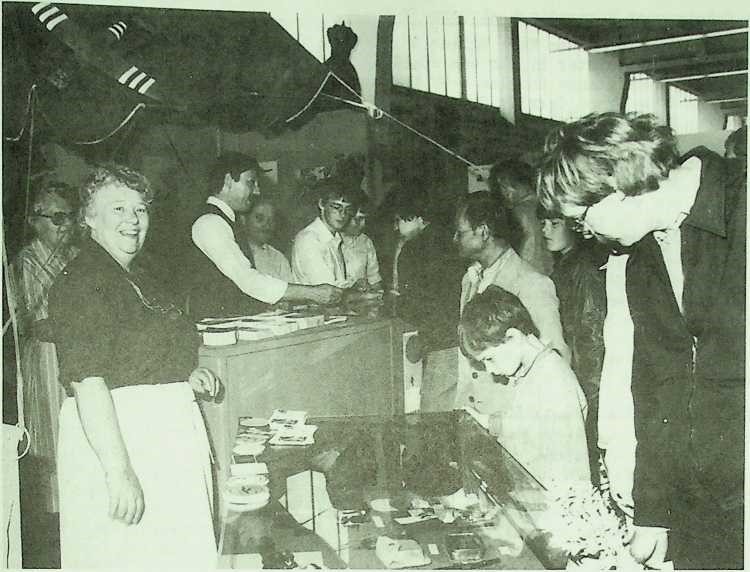
The stand of the Society of Friends of the Airborne Museum at the Air-Base Deelen, during the Open Day of the Royal Air Force.
In the foreground,Mrs de Langen is to be seen to the left.Messis,Berry de Reus,de Ruyter and Jan Smits,our chairman’s son,are to be seen behind the counter.
A set of medals received.
The Airborne Museum has received the set of medals belonging to Sergeant Sidney Goulding. Sergeant Goulding served in the Royal Army Medical Corps from 1938 to 19^7 and in the 10th Battalion The Parachute Regiment from 19^7 to i960. The set is made up of the fol¬lowing medals:Africa Star with bar,Italy Star,France and Germany Star,Defence Medal, War Medal, Coronation Medal and TA Efficiency Medal with bar.
The Polish badge is once again available.
The small badge,depicting the Polish eagle with garland,is once again available in the Museum shop.The Polish eagle with garland was the emblem of the Polish parachutists during the war.This badge costs f.l3,-.A part of these profits is to go to the Polish Veteran Association.
A Polish uniform-coat received.
The Airborne Museum recently came into possession of a uniform-coat belonging to the Polish General Sikorski.During the Second World War,General Sikorski was the founder of the Free Polish Armed Forces,of which the First Polish Parachute Brigade was also a part.He died on the 4th July 19^3,in a ‘plane accident.
The Airborne Museum is well guarded.
In the setting-up of the Airborne Museum in 1978,more than 65,000 guilders were spent on an electronically-guarded installation.This installation safeguards the building against burglary and fire.Moreover,all the showcases and the dioramas are separately guarded against theft.The installation is in direct contact with the police-station and the fire-brigade.
An original Dakota for the Airborne Museum in Normandy.
The Airborne Museum in Sainte Mere Eglise(Normandy) is now in possession of an extremely special attraction.lt is an original American Douglas 0-4? Troup Carrier,which is exhibited in an especially constructed covered area.This example,which belonged to the 439th Troop Carrier Group,is one of the approximately 1000 Dakota’s from which the 82nd and the 101st American Airborne Division made their night jumps over Normandy.This initiative for the “Dakota Museum” originates from Mr.Yves Tariel,chairman of the French “Ligue d’Amitie Parachutists”.Mr Tariel has spend some years on the preparations and organisation of this project,for which he was given..help .from, .a, number, of: insti¬tutions both at home and abroad.Mr Tariel also made a few visits to the Airborne Mu-, seum in Oosterbeek in the course of his investigations into the history of the exhibited Dakota,as well as to the operations in which this machine participated.The Dakota shown in Sainte Mere Eglise in fact also took part in “Operation Market” in September 1944, when the machine transported parachutists from the 82nd American Airborne Division to the dropping-zones near Nijmegen.The moneys which were necessary for the Dakota Museum were mainly collected from veteran parachutists from the 82nd and 101st American Air¬borne Divisions.The opening of the Museum on the 6th June of this year,was attended by a few of the original crew of the machine,who were flown over from America especial¬ly for the occasion.
A new book about the English gliders during the Second World War,
The writer,Alan Lloyd,has just written a new book about English gliders,in which he gi¬ves a general view of the glider’s development and the operations in which gliders have been used.For this purpose,Lloyd has interviewed a great number of veteran glider pilots; their stories form the basis of this book.The role-of the Glider Pilot Regiment has been discussed in a number of books,and yet Lloyd still manages to describe some less known occurences,for example the flying over of thirty Horsa’s to North Africa in pre¬paration for the landing on Sicily.These landings,and particularly the chaotic cir¬cumstances under which they took place,are extensively handled.The glider landings in Normandy,which took place both at night and during the day,were succlsful thanks to the experience gained in Sicily.
Almost a third of the book is about the Battle of Arnhem,in which more than 1200 glider pilots took part.The many eye-witness accounts give a good impression of the landings and the days which followed,during which the glider pilots took on the role of combat troops.The glider pilots were not only committed to defend certain sectors,but they performed,at the same time,the duties of guarding German prisoners-of-war and as guides during the retreat on the 25th and 26th of September 1944.More than half of the glider pilots never returned from the Battle of Arnhem,and the Glider Pilot Regiment had to rapidly replenish its forces in order to prepare for the Rhine crossing in March of 1945. Although it can be said that the glider landings in this operation were generally succ4sful,the losses were nevertheless considerable.lt was the last major airborne operation in which gliders were used.
“The Gliders” by Alan Lloyd,is published by Leo Cooper,London,and costs f.45.45.
MINI-STORY III.Damaged train at the railway bridge in Oosterbeek.
In 1945,there was a passenger train on the railway embankment between the station of Lower Oosterbeek and the railway bridge.
WHO – knows anything about this?
WHAT- had happened?
WHY – had it happened?
WHEN- did it happen?
Would you kindly send your reactions either to Mr.C.van Roekel,Benedendorpsweg 119, Oosterbeek,telephone 085-333261,or directly to the Museum.
Newsletter No,12,
The next Newsletter will appear in November.
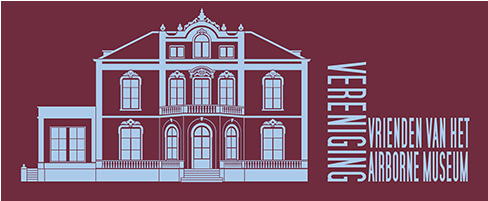
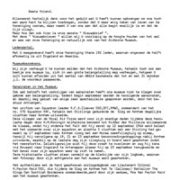
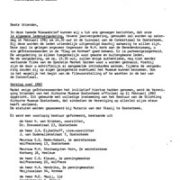
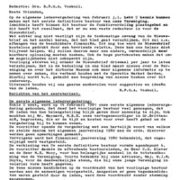
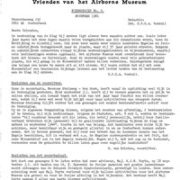
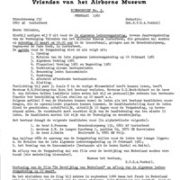
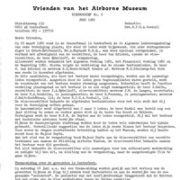
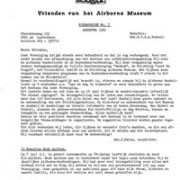
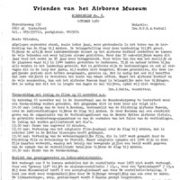
Plaats een Reactie
Vraag of reactie?Laat hier uw reactie achter.